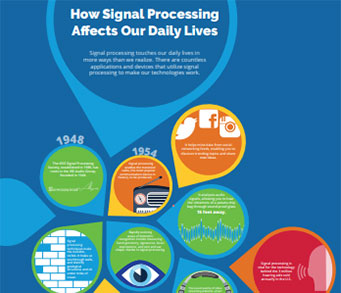SPS Feed
Top Reasons to Join SPS Today!
1. IEEE Signal Processing Magazine
2. Signal Processing Digital Library*
3. Inside Signal Processing Newsletter
4. SPS Resource Center
5. Career advancement & recognition
6. Discounts on conferences and publications
7. Professional networking
8. Communities for students, young professionals, and women
9. Volunteer opportunities
10. Coming soon! PDH/CEU credits
Click here to learn more.
The Latest News, Articles, and Events in Signal Processing
One of the biggest challenges in multimicrophone applications is the estimation of the parameters of the signal model, such as the power spectral densities (PSDs) of the sources, the early (relative) acoustic transfer functions of the sources with respect to the microphones, the PSD of late reverberation, and the PSDs of microphone-self noise.
The transfer of acoustic data across languages has been shown to improve keyword search (KWS) performance in data-scarce settings. In this paper, we propose a way of performing this transfer that reduces the impact of the prevalence of out-of-vocabulary (OOV) terms on KWS in such a setting.
Recently, the binaural auditory-model-based quality prediction (BAM-Q) was successfully applied to predict binaural audio quality degradations, while the generalized power-spectrum model for quality (GPSM q ) has been demonstrated to account for a large variety of monaural signal distortions.
Existing forensic techniques for image manipulation localization crucially assume that probe pixels belong to one of exactly two classes, genuine or manipulated. This letter argues that this convention fuels mis-labeling particularly in unsupervised settings, where singular but genuine...
In smart metering systems, a rechargeable battery can be utilized to protect the privacy of a user from the utility provider by partially masking the load profile of the user. In this line of research on using rechargeable batteries for privacy protection, most existing works have studied only single-user systems using rechargeable batteries.
This letter investigates how to place the received-signal-strength (RSS) sensors to improve the static target localization accuracy in the three-dimensional (3-D) space. By using the A-optimality criterion, i.e., minimizing the trace of the inverse Fisher information matrix (FIM), a new optimal RSS sensor placement strategy is developed when sensors can be placed freely in the 3-D space.
In this letter, we consider the problem of direction-of-arrival (DOA) estimation with one-bit quantized array measurements. With analysis, it is shown that, under mild conditions the one-bit covariance matrix can be approximated by the sum of a scaled unquantized covariance matrix and a scaled identity matrix.
Lecture Date: June 17, 2019
Chapter: Italy
Chapter Chair: Mauro Barni
Topic: Signal Enhancement in Consumer Products
Lecture Date: June 18, 2019
Chapter: Atlanta
Chapter Chair: Alessio Medda
Topic: Distributed Algorithms for Principal Component Analysis
December 10-12, 2019
Location: Ajman, United Arab Emirates
Pages
SPS Social Media
- IEEE SPS Facebook Page https://www.facebook.com/ieeeSPS
- IEEE SPS X Page https://x.com/IEEEsps
- IEEE SPS Instagram Page https://www.instagram.com/ieeesps/?hl=en
- IEEE SPS LinkedIn Page https://www.linkedin.com/company/ieeesps/
- IEEE SPS YouTube Channel https://www.youtube.com/ieeeSPS

















